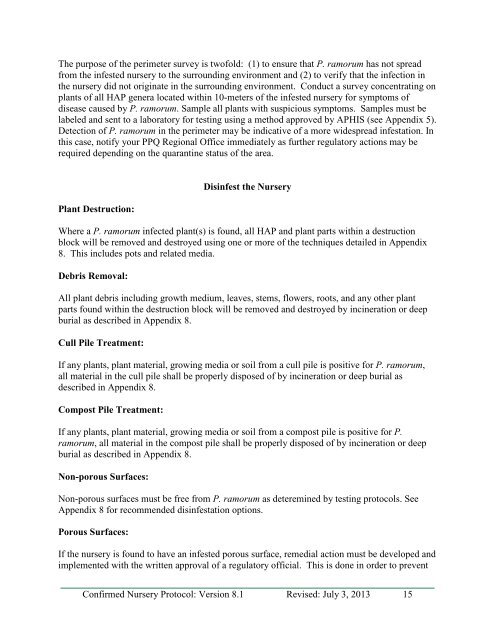Confirmed Nursery Protocol - aphis
Confirmed Nursery Protocol - aphis
Confirmed Nursery Protocol - aphis
Create successful ePaper yourself
Turn your PDF publications into a flip-book with our unique Google optimized e-Paper software.
The purpose of the perimeter survey is twofold: (1) to ensure that P. ramorum has not spread<br />
from the infested nursery to the surrounding environment and (2) to verify that the infection in<br />
the nursery did not originate in the surrounding environment. Conduct a survey concentrating on<br />
plants of all HAP genera located within 10-meters of the infested nursery for symptoms of<br />
disease caused by P. ramorum. Sample all plants with suspicious symptoms. Samples must be<br />
labeled and sent to a laboratory for testing using a method approved by APHIS (see Appendix 5).<br />
Detection of P. ramorum in the perimeter may be indicative of a more widespread infestation. In<br />
this case, notify your PPQ Regional Office immediately as further regulatory actions may be<br />
required depending on the quarantine status of the area.<br />
Plant Destruction:<br />
Disinfest the <strong>Nursery</strong><br />
Where a P. ramorum infected plant(s) is found, all HAP and plant parts within a destruction<br />
block will be removed and destroyed using one or more of the techniques detailed in Appendix<br />
8. This includes pots and related media.<br />
Debris Removal:<br />
All plant debris including growth medium, leaves, stems, flowers, roots, and any other plant<br />
parts found within the destruction block will be removed and destroyed by incineration or deep<br />
burial as described in Appendix 8.<br />
Cull Pile Treatment:<br />
If any plants, plant material, growing media or soil from a cull pile is positive for P. ramorum,<br />
all material in the cull pile shall be properly disposed of by incineration or deep burial as<br />
described in Appendix 8.<br />
Compost Pile Treatment:<br />
If any plants, plant material, growing media or soil from a compost pile is positive for P.<br />
ramorum, all material in the compost pile shall be properly disposed of by incineration or deep<br />
burial as described in Appendix 8.<br />
Non-porous Surfaces:<br />
Non-porous surfaces must be free from P. ramorum as deteremined by testing protocols. See<br />
Appendix 8 for recommended disinfestation options.<br />
Porous Surfaces:<br />
If the nursery is found to have an infested porous surface, remedial action must be developed and<br />
implemented with the written approval of a regulatory official. This is done in order to prevent<br />
<strong>Confirmed</strong> <strong>Nursery</strong> <strong>Protocol</strong>: Version 8.1 Revised: July 3, 2013 15
















